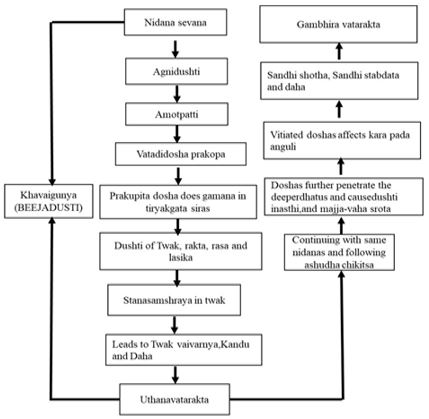Ayurvedic Strategies for Managing Psoriatic Arthritis [Vatarakta] - A Case Study
DOI:
https://doi.org/10.21760/jaims.9.10.45Keywords:
Ayurveda, Psoriatic arthritis, Vatarakta, VirechanaAbstract
Psoriatic arthritis [PsA] is a chronic and progressive inflammatory disease that impacts the skin, joints, and entheses. In 60-70% of cases, psoriasis precedes joint disease in 15-20% of cases, In India the prevalence has been reported as 8.7%. In Ayurveda, PsA can be compared with Vatarakta. Vata and Rakta Dosha play a significant role in Vatarakta. However, it’s important to note that the pathogenesis of Vatarakta involves an amalgamation of deeper Dhatu. A 48-year-old female patient presented with the complaints of severe itching, pinkish rashes characterized by silvery scaling behind the right ear and over the chest, which had persisted for four years. Additionally, the patient experienced pain and stiffness in the joints of her hands [specifically, PIP & DIP joints] and lower back for the past two months. Despite having previously undergone various topical and oral treatments, there were no discernible signs of improvement. The patient was diagnosed with PsA, and subsequently treated with a regimen included Shodhana, Shamana, and Pathya-Apathya. After undergoing Classical Ayurvedic management, the patient experienced improvement in symptoms. In Ayurveda by addressing the root cause through Shodhana, Shamana and Pathya-Apathya offers valuable insights for managing PsA.
Downloads
References
Ibbotson S H. Dermatology In: Ralston S H, Penman I D, Strachan M W, Hobson R P, editors. Davidson’s Principles and Practice of Medicine. 23 rd ed. Edinburgh: Churchill Livingstone Elisevier Ltd; 2018. p. 1032.
Chimenti M S, Caso F, Alivernini S. Amplifying the concept of psoriatic arthritis: The role of autoimmunity in systemic psoriatic disease. https://doi.org/10.1016/ j.autrev.2018.11.007
Helliwell PS. Wright V. Psoriatic arthritis: clinical features. In: Klippel JH, editor; Dieppe PA, editor. Rheumatology. London: Mosby; 1998. 6.21. 1-6, 8. [Google Scholar]
Kumar R, Sharma A, Dogra S. Prevalence and clinical patterns of psoriatic arthritis in Indian patients with psoriasis. Indian J Dermatol Venereol Leprol. 2014;80:15–23. [PubMed] [Google Scholar] [Ref list]
Joel D. Taurog. The Spondyloarthritides. In: Longo D L, Fauci A S, Kasper D L, Hauser S L, Jameson J L, Loscalzo J., editors. Harrison’s Principles of Internal Medicine. Volume 1, Ch. 318, 17 th ed. New Delhi: McGraw-Hill companies; 2008. p. 2115.
ICD-10 Version:2019 [Internet]. Who.int. [cited 2023 Oct 10]. Available from: https://icd.who.int/browse10/ 2019/en#/N46. [Accessed on 10th Oct 2023]
Agnivesha, Charaka samhita of Acharya Charaka, Dridhabala Krit, edited by Vaidya Yadavaji Trikamji Acharya. Chikitsa Sthana. Ch.29, Ver. 20-21. Varanasi: Chaukhambha Sanskrit Sansthan; 2015. p.628.
Lekshmi S. The physiological aspect of snehapana. International Journal of Ayurvedic and Herbal Medicine. 7:6[2017]; v7i6.09.
Agnivesha, Charaka samhita of Acharya Charaka, Dridhabala Krit, edited by Vaidya Yadavaji Trikamji Acharya. Sutra Sthana. Ch.22, Ver. 11. Varanasi: Chaukhambha Sanskrit Sansthan; 2015. p.120.
Tripathi I, editor. Chakradatta with Vaidya prabha Commentary [Hindi], Kusta chikitsa: Ch. 25, Varanasi: Chowkhambha Sanskrit Sanstana; 2005. p. 126.
Bhavamishra. Bhavaprakasha Volume II. 9th ed. Mishra BS, editor. Varanasi: Chaukhambha Sanskrit Sansthan; 2005. p.344
Vagbhata, Astangahrdaya with commentary of Arunadatta, Hemadri Krit, edited by Hari Sadasiva Sastri Paradakara, Chikitsa sthana, Ch. 21, Varanasi: Chaukamba Sanskrit Sansthan; 2007. p. 727.
Govinda Das Sen editor. Bhaisajyaratnavali. Siddhipada Hindi Commentary, Prof. Siddhinandana Mishra editor. 1st edition. Kustharogadhikara, Chapter no-54, Verse no-111-117, Varanasi: Chaukhamba Surbharati Prakashana; 2009.p.871.















